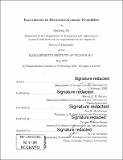Experiments in electroaerodynamic propulsion
Author(s)
Xu, Haofeng, Ph. D. Massachusetts Institute of Technology.
Download1292944621-MIT.pdf (16.05Mb)
Other Contributors
Massachusetts Institute of Technology. Department of Aeronautics and Astronautics.
Terms of use
Metadata
Show full item recordAbstract
Electroaerodynamic (EAD) propulsion, which produces a thrust force by electrokinetic acceleration of ions in air, is a proposed method of electric airplane propulsion that is solid-state, nearly silent, and produces no direct combustion emissions Recent work suggested that EAD-propelled aircraft are possible, although no EAD aircraft had flown prior to this thesis In the first of three experiments described in this thesis, the design of a fixed-wing heavier-than-air prototype airplane with 5m wingspan and 2 45kg takeoff mass was completed and the airplane was tested in-flight An analysis of the flight trajectory showed that this airplane achieved energy-gaining flight, demonstrating that EAD can propel a flying airplane This is a proof-of-concept for electroaerodynamic propulsion The prototype airplane flown in the first experiment carried no useful payload and had an endurance of 90 seconds Two successive experiments assessed potential methods to increase the performance of EAD propulsion One experiment confirmed that increasing the electrode gap spacing from 50 mm to 150 or 200 mm can increase the thrust-to-power of EAD propulsion, provided that certain non-ideal physical effects, which this experiment explained for the first time, are suppressed The other experiment determined that an original "decoupled" EAD architecture, which uses separate ionization and acceleration stages, can increase the thrust density and overcome previously-observed performance trade-offs The results of the latter experiments make possible the development of EAD aircraft with longer endurance, a payload capacity, and which could begin to fulfil useful missions A preliminary design analysis suggests that the increases in thrust-to-power and thrust density resulting from large gap spacing and decoupled thrusters -- among other design and power supply improvements -- can enable payload of 0 2kg and endurance of 10 minutes in an aircraft of approximately 3kg takeoff mass
Description
Thesis: Ph. D., Massachusetts Institute of Technology, Department of Aeronautics and Astronautics, May, 2020 Cataloged from the official PDF of thesis. Includes bibliographical references (pages 89-95).
Date issued
2020Department
Massachusetts Institute of Technology. Department of Aeronautics and AstronauticsPublisher
Massachusetts Institute of Technology
Keywords
Aeronautics and Astronautics.